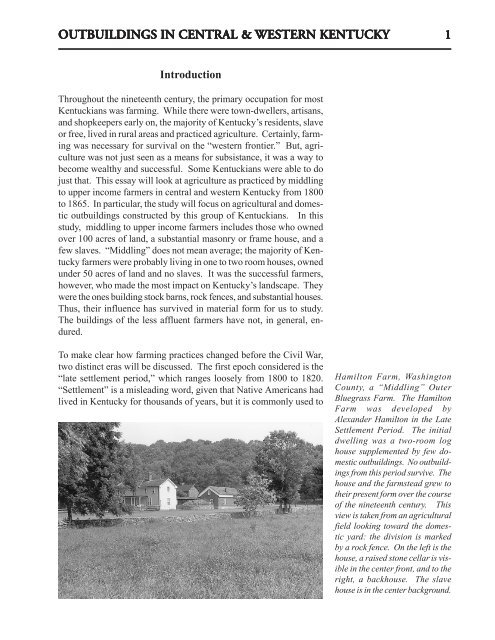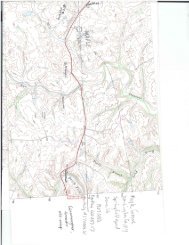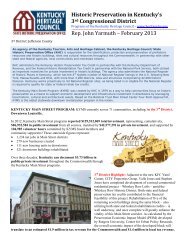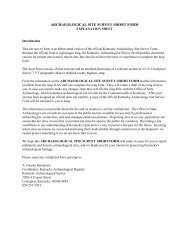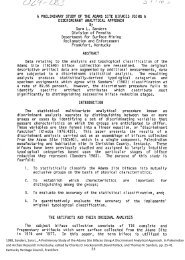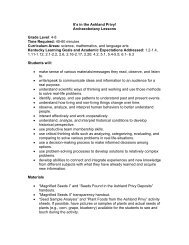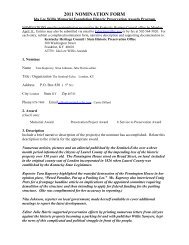Agricultural and Domestic Outbuildings in Central and Western
Agricultural and Domestic Outbuildings in Central and Western
Agricultural and Domestic Outbuildings in Central and Western
You also want an ePaper? Increase the reach of your titles
YUMPU automatically turns print PDFs into web optimized ePapers that Google loves.
OUTB OUTB OUTBUILDINGS OUTB OUTB UILDINGS IN IN CENTRAL CENTRAL & & WESTERN WESTERN KENTUCKY KENTUCKY 1<br />
Introduction<br />
Throughout the n<strong>in</strong>eteenth century, the primary occupation for most<br />
Kentuckians was farm<strong>in</strong>g. While there were town-dwellers, artisans,<br />
<strong>and</strong> shopkeepers early on, the majority of Kentucky’s residents, slave<br />
or free, lived <strong>in</strong> rural areas <strong>and</strong> practiced agriculture. Certa<strong>in</strong>ly, farm<strong>in</strong>g<br />
was necessary for survival on the “western frontier.” But, agriculture<br />
was not just seen as a means for subsistance, it was a way to<br />
become wealthy <strong>and</strong> successful. Some Kentuckians were able to do<br />
just that. This essay will look at agriculture as practiced by middl<strong>in</strong>g<br />
to upper <strong>in</strong>come farmers <strong>in</strong> central <strong>and</strong> western Kentucky from 1800<br />
to 1865. In particular, the study will focus on agricultural <strong>and</strong> domestic<br />
outbuild<strong>in</strong>gs constructed by this group of Kentuckians. In this<br />
study, middl<strong>in</strong>g to upper <strong>in</strong>come farmers <strong>in</strong>cludes those who owned<br />
over 100 acres of l<strong>and</strong>, a substantial masonry or frame house, <strong>and</strong> a<br />
few slaves. “Middl<strong>in</strong>g” does not mean average; the majority of Kentucky<br />
farmers were probably liv<strong>in</strong>g <strong>in</strong> one to two room houses, owned<br />
under 50 acres of l<strong>and</strong> <strong>and</strong> no slaves. It was the successful farmers,<br />
however, who made the most impact on Kentucky’s l<strong>and</strong>scape. They<br />
were the ones build<strong>in</strong>g stock barns, rock fences, <strong>and</strong> substantial houses.<br />
Thus, their <strong>in</strong>fluence has survived <strong>in</strong> material form for us to study.<br />
The build<strong>in</strong>gs of the less affluent farmers have not, <strong>in</strong> general, endured.<br />
To make clear how farm<strong>in</strong>g practices changed before the Civil War,<br />
two dist<strong>in</strong>ct eras will be discussed. The first epoch considered is the<br />
“late settlement period,” which ranges loosely from 1800 to 1820.<br />
“Settlement” is a mislead<strong>in</strong>g word, given that Native Americans had<br />
lived <strong>in</strong> Kentucky for thous<strong>and</strong>s of years, but it is commonly used to<br />
Hamilton Farm, Wash<strong>in</strong>gton<br />
County, a “Middl<strong>in</strong>g” Outer<br />
Bluegrass Farm. The Hamilton<br />
Farm was developed by<br />
Alex<strong>and</strong>er Hamilton <strong>in</strong> the Late<br />
Settlement Period. The <strong>in</strong>itial<br />
dwell<strong>in</strong>g was a two-room log<br />
house supplemented by few domestic<br />
outbuild<strong>in</strong>gs. No outbuild<strong>in</strong>gs<br />
from this period survive. The<br />
house <strong>and</strong> the farmstead grew to<br />
their present form over the course<br />
of the n<strong>in</strong>eteenth century. This<br />
view is taken from an agricultural<br />
field look<strong>in</strong>g toward the domestic<br />
yard: the division is marked<br />
by a rock fence. On the left is the<br />
house, a raised stone cellar is visible<br />
<strong>in</strong> the center front, <strong>and</strong> to the<br />
right, a backhouse. The slave<br />
house is <strong>in</strong> the center background.


